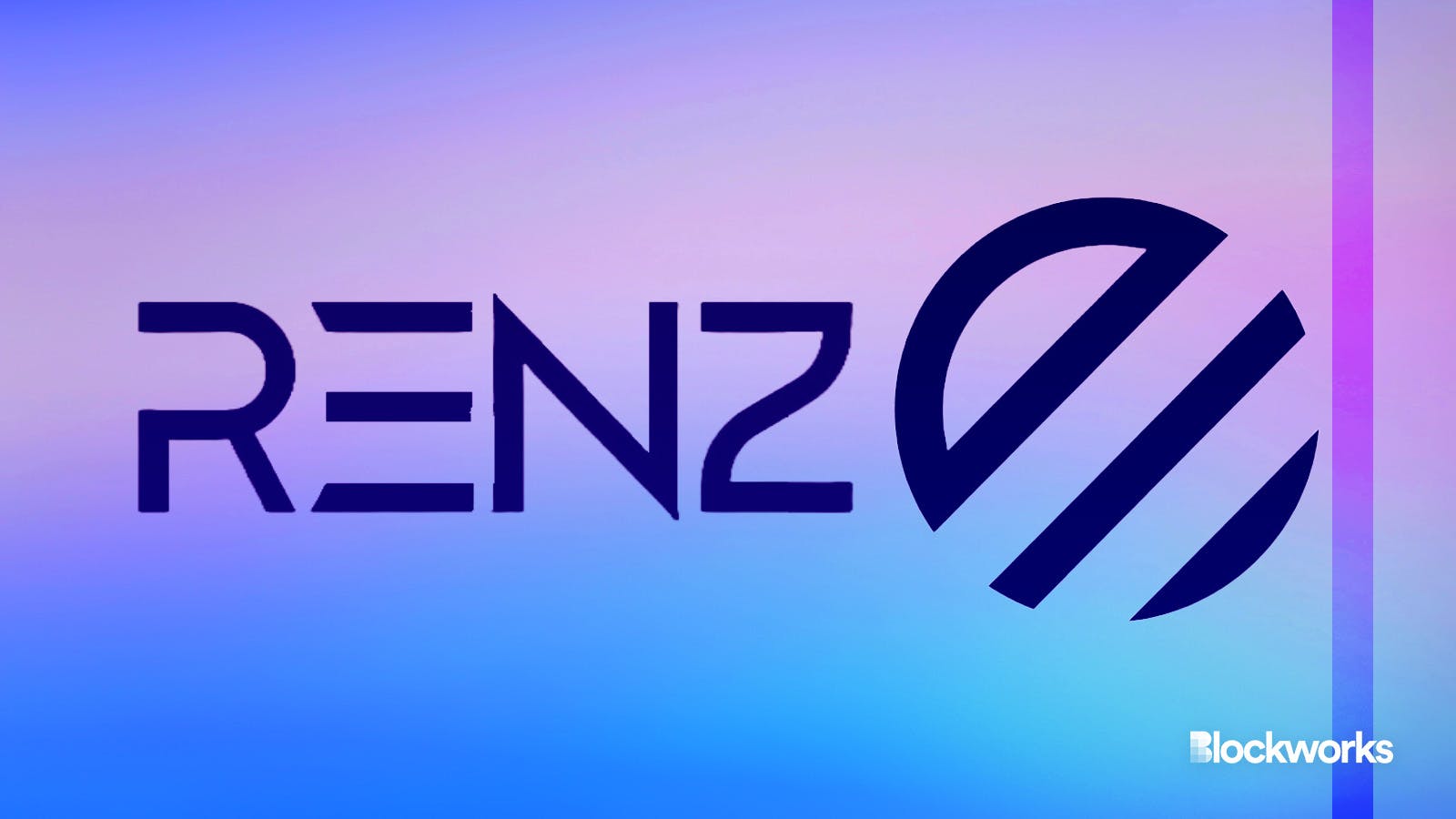What was behind the run on Renzo’s liquid restaked ETH?
Renzo benefitted from the hyped up restaking narrative and points bonanza

Renzo and Adobe Stock modified by Blockworks
Liquid staking protocol Renzo experienced explosive growth in 2024, rocketing to a peak of just over 1 million ether in deposits worth about $3.3 billion.
As with many protocols spinning up around EigenLayer, the surge in deposits was driven by points incentives, not only for depositing ETH directly with Renzo but including more speculative opportunities.
Partnerships with other DeFi protocols encouraged holders of Renzo’s ezETH liquid staking token (LRT) to boost their points via leveraged vaults, for instance with Morpho and Gearbox.
Since ezETH and ETH are typically correlated, the assets can theoretically be “looped” by depositing ezETH, borrowing ETH and restaking it to acquire more ezETH. This process is then repeated multiple times in order to maximize returns.
But when ezETH experienced a sudden rush of sellers following a perceived misstep in the release of upcoming airdrop allocations earlier this week, that correlation broke down, causing liquidations.
Read more: The risks of restaking are extremely overrated
Some users lost millions.
Morpho’s ezETH TVL at the time was sitting above $700 million.
Gearbox co-founder Ivan GBI, on an X space about the incident, noted that anyone with over about 6x leverage got liquidated.
The issue was not one of insolvency, but illiquidity. Every ezETH is backed by 1 ETH staked with a validator and restaked with EigenLayer, but unwinding those staking operations takes time, and in Renzo’s case is not yet even possible — the protocol has yet to enable withdrawals.
The only way to access the underlying ETH quickly was to sell using on-chain liquidity pools. As it turns out, it doesn’t take much of a push to unbalance those pools enough to cause a panic, according to Mike Silagadze, co-founder of LRT protocol EtherFi.
“Even with one in a thousand users wanting to go in and redeem their tokens, that was sufficient to cause the peg to move a little bit,” Silagadze said.
“This was not some crazy wild or unusual thing it was actually perfectly predictable expected user behavior,” he said, referring to the end of Renzo’s initial points program.
How could it have been avoided?
The biggest problem was the lack of withdrawals, which are expected to go live next month.
As of today, a team member in the project’s official Discord wrote they did not have “an exact date but very soon,” mentioning “early May” as likely, following the completion of audits and other code reviews.
That uncertainty makes it tricker for prospective arbitragers to estimate their opportunity cost by buying up the discounted staking derivative tokens and restoring the balance.
As of now, 1 ezETH trades about 1.7% below 1 ETH.
Even in the best of times, there will be a week-long delay unstaking from EigenLayer, so one could imagine an illiquidity discount being the norm, all else being equal.
Of course, ongoing incentives in the form of points and future tokens weighs into each individual trader’s decision.
The situation is not unlike the deviation from target price that struck Lido’s stETH in May 2022, prior to Ethereum’s Shapella upgrade, which made it possible to withdraw staked ether for the first time.
In contrast, EtherFi has always had the ability to redeem eETH for ETH, so only the potential withdrawal delay is a consideration.
The protocol maintains a “liquidity pool reserve” but EtherFi’s withdrawal user interface warns users, “if there is not enough ETH in the liquidity pool reserve to fulfil your request, the protocol will need to exit validators in order to complete this transaction.”
EigenLayer itself also has a roughly 7 day withdrawal period.
Read from our opinion section: Restaking is a ticking time bomb
Under normal circumstances, the liquidity pool reserve should allow for 1:1 redemption of eETH in 4-12 hours, Silagadze said.
“After our [token generation event] back in mid-March, EtherFi did have a pretty large amount of withdrawals,” he recalled, but with withdrawals enabled, “when people were looking to exit the protocol, rather than sapping on-chain the majority of people just went directly to the protocol and requested withdrawals.”
That feature, combined with about $30 million in on-chain liquidity, prevented any issues with its convertibility back into ether. Today, eETH to ETH liquidity has more than tripled to $100 million.
Alternative LRT protocol Swell enabled withdrawals of its liquid staked swETH token in February and allows conversion between its EigenLayer restaked version rswETH and swETH through its app.
Read more: Swell launches its own layer-2 for restaking with Polygon CDK
Another difference Silagadze flagged is that a much lower percentage of eETH was in use in leveraged loops, compared to other LRTs.
He called the use of leverage “a very problematic behavior that we see with LRTs, which are very complex assets.”
Even a small breakdown on the order of 1-2% can provoke a liquidation cascade as the leverage protocols are forced to sell the LRT, further destabilizing it. And it can happen fast, without much warning. The initial ezETH crash occurred in less than 20 minutes — so without automated processes in place to detect trouble and repay debt or add collateral, points farmers can easily find themselves wiped out while they sleep.
The Renzo team has not directly addressed the deviation of ezETH through its Discord announcements or X channels, but has revised its planned airdrop in response to criticism. The token distribution of 7% of the total supply is now set to begin Tuesday, April 30.
Start your day with top crypto insights from David Canellis and Katherine Ross. Subscribe to the Empire newsletter.





